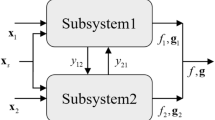Abstract
The collaboration pursuing method (CPM) is a computationally efficient approach for deterministic multidisciplinary design optimization (MDO). However, it has not been employed to handle problems with uncertainty. Moreover, obtaining actual uncertainty probability distributions is challenging. Compared to probability distributions, the interval information of uncertainties can be more easily obtained. Thus, multidisciplinary robust design optimization (MRDO) under interval uncertainty has been widely investigated. To overcome the inefficiency of existing methods for solving MRDO, this paper proposes an improved collaboration pursuing method (ICPM). In this method, the collaboration model (CM) is utilized to filter the samples that satisfy the coupled state equations in system analysis (SA) or multidisciplinary analysis (MDA). Then, a robustness discrepancy model (RDM) is developed to efficiently select candidate samples that meet the robustness requirements. Next, the mode pursuing sampling (MPS) method is utilized as a global optimizer to drive the optimization process and identify the robust optimum. Finally, a mathematical example and two engineering examples are utilized to evaluate the feasibility and effectiveness of the proposed method.
















Similar content being viewed by others
References
Antoine NE, Kroo IM (2005) Framework for aircraft conceptual design and environmental performance studies. AIAA J 43(10):2100–2109
Brevault L, Balesdent M, Berend N, Le Riche R (2016) Decoupled multidisciplinary design optimization formulation for interdisciplinary coupling satisfaction under uncertainty. AIAA J 54(1):186–205
Du X, Chen W (2005) Collaborative reliability analysis under the framework of multidisciplinary systems design. Optim Eng 6(1):63–84
Fu JC, Wang LQ (2002) A random-discretization based Monte Carlo sampling method and its applications. Methodol Comput Appl Probab 4(1):5–25
Fuglsang P et al (2002) Site-specific design optimization of wind turbines. Wind Energy 5(4):261–279
Gu X, Renaud JE, Penninger CL (2006) Implicit uncertainty propagation for robust collaborative optimization. ASME J Mech Des 128(4):1001–1013
Hu W, Azarm S, Almansoori A (2013) New approximation assisted multi-objective collaborative robust optimization (new AA-McRO) under interval uncertainty. Struct Multidiscip Optim 47(1):19–35
Li M, Azarm S (2008) Multi-objective collaborative robust optimization with interval uncertainty and interdisciplinary uncertainty propagation. ASME J Mech Des 130(8):081402
Liu H, Chen W, Kokkolaras M, Papalambros P, Kim H (2006) Probabilistic analytical target cascading—a moment matching formulation for multilevel optimization under uncertainty. ASME J Mech Des 128(4):991–1000
McAllister CD, Simpson TW (2003) Multidisciplinary robust design optimization of an internal combustion engine. ASME J Mech Des 125(1):124–130
Parsons MG, Randall LS (2004) Formulation of multi-criterion design optimization problems for solution with scalar numerical optimization methods. J Ship Res 48(1):61–76
Peri D, Campana EF (2003) Multidisciplinary design optimization of a naval surface combatant. J Ship Res 47(1):1–12
Sellar RS (1997) Multidisciplinary design using artificial neural networks for discipline coordination and system optimization [D]. University of Notre Dame, Indiana
Shan S, Wang GG (2005) An efficient pareto set identification approach for multi-objective optimization on black-box functions. ASME J Mech Des 127(5):866–874
Simpson TW, Martins JRRA (2011) Multidisciplinary design optimization for complex engineered systems: report from a national science foundation workshop. ASME J Mech Des 133(10):101002
Sobieszczanski-Sobieski J, Haftka RT (1997) Multidisciplinary aerospace design optimization: survey of recent developments. Struct Optim 14(1):1–23
Sun W, Wang X, Wang L, Zhang J, Song X (2016) Multidisciplinary design optimization of tunnel boring machine considering both structure and control parameters under complex geological conditions. Struct Multidiscip Optim 54(4):1073–1092
Wang LQ, Shan SQ, Wang GG (2004) Mode-pursuing sampling method for global optimization on expensive black-box functions. Eng Optim 36(4):419–438
Wang DP, Wang GG, Naterer GF (2007a) Collaboration pursuing method for multidisciplinary design optimization problems. AIAA J 45(5):1091–1103
Wang DP, Wang GG, Naterer GF (2007b) Extended collaboration pursuing method for solving larger multidisciplinary design optimization problems. AIAA J 45(6):1208–1221
Wang X, Li M, Liu Y, Sun W, Song X, Zhang J (2017a) Surrogate based multidisciplinary design optimization of lithium-ion battery thermal management system in electric vehicles. Struct Multidiscip Optim 56(6):1555–1570
Wang X, Wang R, Chen X, Wang L, Geng X, Fan W (2017b) Interval prediction of responses for uncertain multidisciplinary system. Struct Multidiscip Optim 55(6):1945–1964
Wang X, Wang R, Wang L, Chen X, Geng X (2018) An efficient single-loop strategy for reliability-based multidisciplinary design optimization under non-probabilistic set theory. Aerosp Sci Technol 73:148–163
Wujek BA, Renaud JE, Batill SM, Johoson EW, Brockman, J B (1996) Design flow management and multidisciplinary design optimization in application to aircraft concept sizing. AIAA-96-0713, 34th aerospace sciences meeting & exhibit, Reno, NY
Xia T, Li M, Zhou J (2016) A sequential robust optimization approach for multidisciplinary design optimization with uncertainty. ASME J Mech Des 138(11):111406
Xiao M, Gao L, Xiong H, Luo Z (2015) An efficient method for reliability analysis under epistemic uncertainty based on evidence theory and support vector regression. J Eng Des 26(10–12):340–364
Xiao NC, Zuo MJ, Zhou C (2018) A new adaptive sequential sampling method to construct surrogate models for efficient reliability analysis. Reliab Eng Syst Saf 169:330–338
Yao W, Chen X, Ouyang Q, van Tooren M (2013) A reliability-based multidisciplinary design optimization procedure based on combined probability and evidence theory. Struct Multidiscip Optim 48(2):339–354
Zaman K, Mahadevan S (2013) Robustness-based design optimization of multidisciplinary system under epistemic uncertainty. AIAA J 51(5):1021–1031
Zhou J, Li M, Xu M (2015) A new sequential multidisciplinary optimization method for bi-level decomposed systems. ASME 2015 International design engineering technical conferences and computers and information in engineering conference. American Society of Mechanical Engineers, V02BT03A031-V02BT03A031
Funding
This work was supported by the National Natural Science Foundation of China [grant numbers 51675196 and 51721092] and the Program for HUST Academic Frontier Youth Team.
Author information
Authors and Affiliations
Corresponding author
Additional information
Responsible editor: Pingfeng Wang
Appendix
Appendix
1.1 Aircraft sizing problem
The details of the model are given in Table 16. The empty weight includes four parts: (1) the aircraft structure, (2) the landing gear, (3) the propulsion system, and (4) the equipment.
Rights and permissions
About this article
Cite this article
Li, W., Xiao, M. & Gao, L. Improved collaboration pursuing method for multidisciplinary robust design optimization. Struct Multidisc Optim 59, 1949–1968 (2019). https://doi.org/10.1007/s00158-018-2165-2
Received:
Revised:
Accepted:
Published:
Issue Date:
DOI: https://doi.org/10.1007/s00158-018-2165-2




